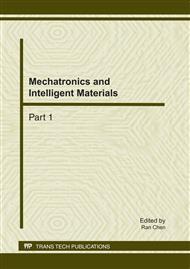[1]
E. Fishler, A. Haimovich, R. Blum, L. Cimini, D. Chizhik and R. Valenzuela: MIMO radar: An idea whose time has come. In Proc. IEEE Radar Conference, Philadelphia, PA, Apr. 2004, p.71–78.
DOI: 10.1109/nrc.2004.1316398
Google Scholar
[2]
E. Fishier, A. Haimovich, R. Blum, J. Cimini, D. Chizhik and R. Valenzuela: Spatial diversity in radars-models and detection performance. Signal Processing, IEEE Trans, Mar 2006, Vol. 54, No. 3, pp.823-838.
DOI: 10.1109/tsp.2005.862813
Google Scholar
[3]
A. Haimovich, R. Blum and L. Cimini: MIMO radars with widely separated antennas. IEEE Signal Processing Magazine, Jan. 2008, Vol. 25, No. 1, p.1053–5888.
DOI: 10.1109/msp.2008.4408448
Google Scholar
[4]
A. de Maio and M. Lops: Design principles of MIMO radar detectors. IEEE Trans. On Aero- space and Electronic Systems, Jul. 2007, Vol. 43, No. 3, pp.886-898.
DOI: 10.1109/taes.2007.4383581
Google Scholar
[5]
L. Xu and J. Li: Iterative generalized-likelihood ratio test for MIMO radar. IEEE Trans, On Signal Processing, Jun. 2007, Vol. 55, No. 6, pp.2375-2385.
DOI: 10.1109/tsp.2007.893937
Google Scholar
[6]
G H Jajamovich, M Lopes and X D Wang: Transmit Policies for MIMO Radar Detection and Time-Delay Estimation. Proc. Of the 4th ISCCSP, March, 2010, Limassol, Cyprus, pp.1-4.
DOI: 10.1109/isccsp.2010.5463444
Google Scholar
[7]
L Venturino, K Dong, X D Wang and M Lopes: A stochastic-gradient method to design optimal space-time codes for MIMO radar detection. European Wireless Conference, April, 2010, pp.752-757.
DOI: 10.1109/ew.2010.5483418
Google Scholar
[8]
G Cui, L J Kong, X B Yang and J Y Yang: Two-Step GLRT Design of MIMO radar in Compound-Gaussian Clutter. IEEE, 2010, Radar Conference, pp.343-347.
DOI: 10.1109/radar.2010.5494600
Google Scholar
[9]
K. Gerlach: Spatially distributed targets detection in non-Gaussian clutter. IEEE Trans, On Aerospace and Electronic Systems, Jul. 1999, Vol. 35, No. 3, pp.926-934.
DOI: 10.1109/7.784062
Google Scholar
[10]
F. Gini; M.V. Greco: Covariance matrix estimation for CFAR detection in correlated heavy tailed clutter. Signal Processing, Dec 2002, Vol. 82, No. 12, pp.1847-1895.
DOI: 10.1016/s0165-1684(02)00315-8
Google Scholar


